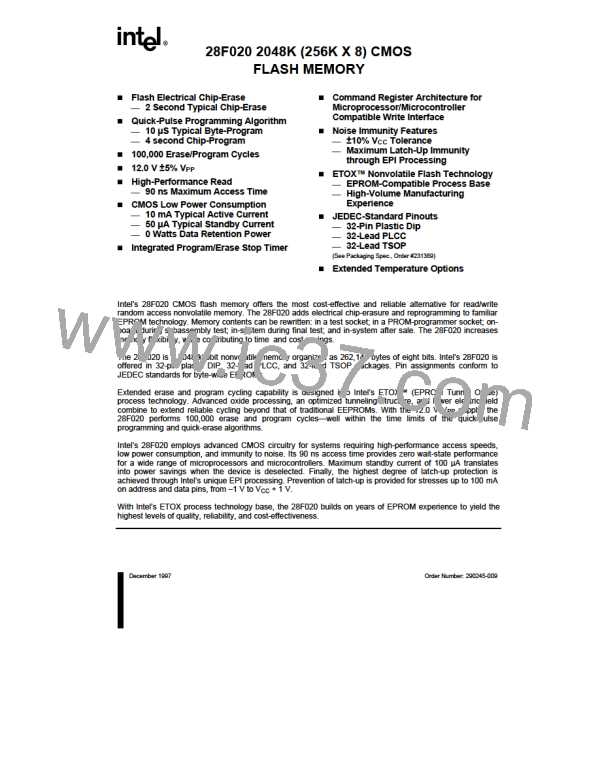E
28F020
connections,
manufacture, and update flexibility.
while
adding
greater
test,
1.0 APPLICATIONS
The 28F020 flash memory provides nonvolatility
along with the capability to perform over 100,000
electrical chip-erasure/reprogram cycles. These
features make the 28F020 an innovative alternative
to disk, EEPROM, and battery-backed static RAM.
Where periodic updates of code and data tables
are required, the 28F020’s reprogrammability and
nonvolatility make it the obvious and ideal
replacement for EPROM.
Material and labor costs associated with code
changes increases at higher levels of system
integration—the most costly being code updates
after sale. Code “bugs,” or the desire to augment
system functionality, prompt after sale code
updates. Field revisions to EPROM-based code
requires the removal of EPROM components or
entire boards. With the 28F020, code updates are
implemented locally via an edge connector, or
remotely over a communications link.
Primary applications and operating systems stored
in flash eliminate the slow disk-to-DRAM download
process. This results in dramatic enhancement of
performance and substantial reduction of power
For systems currently using a high-density static
RAM/battery configuration for data accumulation,
flash memory’s inherent nonvolatility eliminates the
need for battery backup. The concern for battery
failure no longer exists, an important consideration
for portable equipment and medical instruments,
both requiring continuous performance. In addition,
flash memory offers a considerable cost advantage
over static RAM.
consumption—a
consideration
particularly
important in portable equipment. Flash memory
increases flexibility with electrical chip-erasure and
in-system update capability of operating systems
and application code. With updatable code, system
manufacturers can easily accommodate last-
minute changes as revisions are made.
Flash memory’s electrical chip-erasure, byte
programmability and complete nonvolatility fit well
with data accumulation and recording needs.
Electrical chip-erasure gives the designer a “blank
slate” in which to log or record data. Data can be
periodically off-loaded for analysis and the flash
memory erased producing a new “blank slate.”
In diskless workstations and terminals, network
traffic reduces to a minimum and systems are
instant-on. Reliability exceeds that of electro-
mechanical media. Often in these environments,
power interruptions force extended re-boot periods
for all networked terminals. This mishap is no
longer an issue if boot code, operating systems,
communication protocols and primary applications
are flash resident in each terminal.
A
high degree of on-chip feature integration
simplifies memory-to-processor interfacing. Figure
3 depicts two 28F020s tied to the 80C186 system
bus. The 28F020’s architecture minimizes interface
circuitry needed for complete in-circuit updates of
memory contents.
For embedded systems that rely on dynamic
RAM/disk for main system memory or nonvolatile
backup storage, the 28F020 flash memory offers a
solid state alternative in a minimal form factor. The
28F020 provides higher performance, lower power
consumption, instant-on capability, and allows an
“eXecute in place” (XIP) memory hierarchy for
code and data table reading. Additionally, the flash
memory is more rugged and reliable in harsh
environments where extreme temperatures and
shock can cause disk-based systems to fail.
The outstanding feature of the TSOP (Thin Small
Outline Package) is the 1.2 mm thickness. TSOP
is particularly suited for portable equipment and
applications requiring large amounts of flash
memory.
With cost-effective in-system reprogramming,
extended cycling capability, and true nonvolatility,
the 28F020 offers advantages to the alternatives:
EPROMs, EEPROMs, battery backed static RAM,
or disk. EPROM-compatible read specifications,
straightforward interfacing, and in-circuit alterability
offers designers unlimited flexibility to meet the
high standards of today’s designs.
The need for code updates pervades all phases of
a
system’s life—from prototyping to system
manufacture to after sale service. The electrical
chip-erasure and reprogramming ability of the
28F020 allows in-circuit alterability; this eliminates
unnecessary handling and less reliable socketed
5

 INTEL [ INTEL ]
INTEL [ INTEL ]